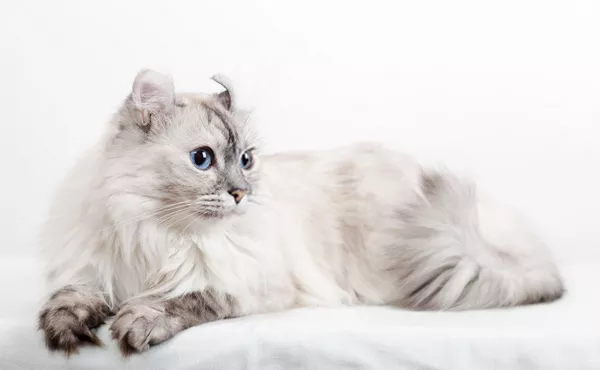The American Curl is one of the most distinctive and beloved cat breeds in the world. With its signature curled-back ears, playful nature, and loving disposition, the breed has captured the hearts of cat enthusiasts globally. As with all cats, owners often notice changes in their pet‘s appearance over time, particularly in their fur. One common question among American Curl owners is whether American Curl cats become fluffier as they age. In this article, we will explore the American Curl’s breed characteristics, their fur types, and how age may or may not impact their fluffiness. Along the way, we will delve into the breed’s history, lifestyle habits, and care requirements, offering a comprehensive guide for both potential and experienced owners.
Introduction to the American Curl: A Breed Like No Other
The American Curl is renowned for one very distinct feature: its backward-curling ears. This trait sets the breed apart from all other cats and gives it a unique and almost whimsical appearance. The curling of the ears is due to a spontaneous genetic mutation that occurred in a domestic cat in Lakewood, California, in 1981. The breed’s founder, Shulamith, a stray cat with curled ears, gave birth to a litter of kittens that inherited her unusual ear structure. From this small beginning, a breed was established, and it was officially recognized by cat registries, including The International Cat Association (TICA) and the Cat Fanciers’ Association (CFA).
Aside from their distinctive ears, American Curls are medium-sized cats with a muscular build, graceful bodies, and alert expressions. Their personality is often described as sociable, affectionate, and intelligent. They are known to form strong bonds with their families and are often compared to dogs in their loyalty and companionship.
Fur Types of the American Curl: Longhaired vs. Shorthaired
When discussing whether American Curls get fluffier with age, it’s essential first to understand that this breed comes in two coat varieties: longhaired and shorthaired.
Shorthaired American Curl: The shorthaired variety of the American Curl has a silky, soft coat that lies close to the body. It does not have an undercoat, which means it feels sleek to the touch and typically doesn’t give the impression of fluffiness. While shorthaired Curls may exhibit some increase in fur volume as they mature, especially during colder months or with seasonal shedding, they are not generally considered to become noticeably fluffier with age.
Longhaired American Curl: The longhaired variant has a semi-long, flowing coat. Although it is not as thick as the fur of some longhaired breeds like the Persian, it still has a luxurious quality. Longhaired American Curls are often perceived as fluffier, and their fur tends to develop more volume as they age, particularly as their full adult coat comes in.
Development of the Coat: Do American Curls Get Fluffier Over Time?
Many American Curl owners notice that their cats appear to grow fluffier as they age, especially if they have the longhaired variety. This is not an illusion. Like many other cat breeds, the fur of an American Curl changes as it transitions from kittenhood to adulthood and even as it ages into its senior years. However, several factors influence whether this breed truly becomes fluffier with age:
Kitten to Adult Transition
When American Curl kittens are born, they are covered in a fine, soft baby coat that tends to be less dense and fluffy than their adult coat. Between six months and one year of age, kittens will go through a molting period in which they shed their kitten coat and grow their adult fur. During this period, the coat can appear patchy or sparse, but as the adult coat fills in, longhaired American Curls, in particular, will often appear fluffier than they did as kittens.
Adult Coat Development
Around the age of 2 to 3 years, American Curls reach full maturity, and this includes the complete development of their adult coat. For longhaired American Curls, this means their fur may become longer and fuller, giving them a more plush appearance. The fur will be at its densest, and grooming practices will play a role in maintaining the fluffiness of their coat.
Shorthaired American Curls also undergo this process, but the differences are less dramatic. Their sleek coats will develop more luster and smoothness with age, but without the long fur, they do not achieve the same degree of fluffiness as their longhaired counterparts.
Seasonal Shedding and Fur Thickness
Seasonal changes can also play a role in how fluffy an American Curl appears. Cats naturally shed more in warmer months and grow a thicker coat in colder months. For longhaired American Curls, the winter coat can appear particularly fluffy as they grow a denser layer of fur to insulate against cold temperatures. This seasonal fluffiness may be less noticeable in shorthaired varieties, but they too will grow a slightly denser coat during the colder seasons.
Senior Years: Does the Fluffiness Continue?
As American Curls enter their senior years, typically around the age of 10 or older, their coats may undergo further changes. Some cats may experience thinning of the fur as part of the natural aging process, while others may retain their fluffiness well into old age. The key to maintaining a healthy and fluffy coat, especially in senior cats, lies in proper nutrition, grooming, and overall health management.
Factors Affecting the Fluffiness of American Curls
While age certainly plays a role in the development of an American Curl’s coat, other factors can also influence how fluffy a cat becomes. These include genetics, diet, grooming practices, and environmental conditions.
Genetics
As with all animals, genetics play a significant role in determining coat quality and texture. Even within the same litter, some American Curls may inherit genes for longer or denser fur than their siblings. If a kitten is born from parents with particularly fluffy coats, it is more likely to develop a fluffier appearance as it matures.
Diet and Nutrition
A healthy, well-balanced diet is essential for maintaining a cat’s overall health, and this includes the quality of its coat. Cats that receive proper nutrition, particularly diets rich in omega-3 and omega-6 fatty acids, are more likely to have shiny, healthy, and fluffy fur. Malnutrition or deficiencies in essential nutrients can lead to a dull, thinning coat, which will detract from the cat’s overall fluffiness.
Grooming Practices
Regular grooming is especially important for longhaired American Curls. Brushing helps to remove loose fur, prevent matting, and stimulate the skin to produce natural oils that keep the fur soft and shiny. Cats that are brushed regularly are more likely to maintain a fluffy appearance, as grooming prevents the fur from becoming tangled or greasy. Shorthaired American Curls require less frequent grooming, but regular brushing can still help to enhance the sleekness of their coats.
See Also: How Much Are Purebred American Curl?
Environmental Factors
The environment in which a cat lives can also influence the condition of its coat. For example, cats living in colder climates may naturally grow thicker, fluffier coats in response to the temperature. Conversely, cats that live in warmer climates may have lighter, less dense fur. Indoor cats may also experience fewer fluctuations in their coat thickness compared to outdoor cats, whose coats adapt to the changing seasons more dramatically.
Caring for Your American Curl: Tips for a Fluffy, Healthy Coat
Whether your American Curl has short or long hair, taking proper care of its coat is essential for keeping it in top condition. Here are some tips to ensure your cat remains healthy and, if longhaired, continues to flaunt a fluffy coat:
Brushing and Grooming
For longhaired American Curls, regular grooming is crucial to prevent mats and tangles from forming. Aim to brush your cat’s coat at least two to three times a week using a soft-bristle brush or a comb designed for long-haired breeds. Shorthaired Curls can benefit from weekly brushing to remove dead hair and distribute natural oils throughout their coat.
Bathing
Bathing is not typically required for cats, as they are fastidious groomers. However, if your American Curl’s fur becomes particularly greasy or dirty, an occasional bath with a cat-safe shampoo can help refresh the coat and improve its appearance. Be sure to dry your cat thoroughly after bathing to prevent mats from forming in longhaired cats.
Diet and Hydration
A high-quality, balanced diet is key to maintaining a shiny, healthy coat. Look for cat foods that contain essential fatty acids, vitamins, and minerals to support skin and coat health. Additionally, ensure your cat has access to fresh water at all times to stay hydrated, as dehydration can lead to dry skin and a lackluster coat.
Regular Vet Check-ups
Regular veterinary visits are important to catch any underlying health issues that may affect your cat’s coat. Skin infections, allergies, and hormonal imbalances can all impact the quality of a cat’s fur, so maintaining your cat’s overall health is essential for a fluffy, beautiful coat.
Conclusion
In summary, whether or not an American Curl becomes fluffier with age depends largely on the individual cat and its specific coat type. Longhaired American Curls are more likely to develop a fluffy appearance as they mature, particularly after they shed their kitten coat and grow their full adult fur. Shorthaired American Curls, on the other hand, do not become as fluffy, but their sleek coats can become more polished and lustrous with age.
Factors such as genetics, diet, grooming, and environment all play critical roles in determining the fluffiness of an American Curl’s coat. With proper care and attention, both longhaired and shorthaired American Curls can maintain beautiful, healthy fur throughout their lives.
Ultimately, while the question of whether American Curls get fluffier with age is nuanced, one thing remains clear: this charming breed continues to captivate and delight cat lovers, no matter how fluffy they may become.
Related Topics:


























